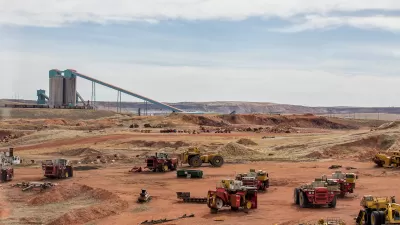It's only taken a week for the coal industry to get swept under the rug, to an extent, by Republican leadership in Washington, D.C.—not to mention their energy market competitors.

"ExxonMobil has just dropped a tweet in support of putting the Paris climate agreement into force," according to a post by Tina Casey. "Connect the dots, and that means the Trump Administration is poised to throw coal under the bus."
The tweet came from Suzanne McCarron, ExxonMobil's Vice President of Public and Government Affairs, and reads as follows while linking to the Paris Climate Agreement.
The Paris agreement is an important step forward by governments in addressing the serious risks of #ClimateChange https://t.co/X7JubyyArv
— Suzanne McCarron (@SuzanneMcCarron) November 10, 2016
Before the end of the article, Casey casts doubt on the seriousness of this pro-environmental statement from McCarron, noting the company's shift toward shale gas reserves.
A big component of the story, however, is coal's position as a political and economic power. "This is probably not what the US coal industry had in mind when it lobbied — successfully — to put a President Donald Trump in charge of US energy policy," writes Casey, and events since Election Day have hinted at a rude awakening for the coal industry (from executive levels down to the laid-off workers who voted for Trump hoping that he would revive the industry). A separate article by Joseph Garth reported that "U.S. Senate Majority Leader Mitch McConnell hedged on Friday about when and if Republicans would be able to bring coal mining jobs to Kentucky, saying that is a 'private sector activity.'"
FULL STORY: Stabbed In The Back! ExxonMobil Throws Shade At US Coal Industry

Planetizen Federal Action Tracker
A weekly monitor of how Trump’s orders and actions are impacting planners and planning in America.

Chicago’s Ghost Rails
Just beneath the surface of the modern city lie the remnants of its expansive early 20th-century streetcar system.

San Antonio and Austin are Fusing Into one Massive Megaregion
The region spanning the two central Texas cities is growing fast, posing challenges for local infrastructure and water supplies.

Trump Distributing DOT Safety Funds at 1/10 Rate of Biden
Funds for Safe Streets and other transportation safety and equity programs are being held up by administrative reviews and conflicts with the Trump administration’s priorities.

German Cities Subsidize Taxis for Women Amid Wave of Violence
Free or low-cost taxi rides can help women navigate cities more safely, but critics say the programs don't address the root causes of violence against women.

New Atlanta Law Requires ‘Cool Roofs’
Painting roofs with reflective coatings can significantly reduce indoor temperatures and improve energy efficiency, sometimes at a lower cost than traditional roof treatments.
Urban Design for Planners 1: Software Tools
This six-course series explores essential urban design concepts using open source software and equips planners with the tools they need to participate fully in the urban design process.
Planning for Universal Design
Learn the tools for implementing Universal Design in planning regulations.
planning NEXT
Appalachian Highlands Housing Partners
Mpact (founded as Rail~Volution)
City of Camden Redevelopment Agency
City of Astoria
City of Portland
City of Laramie



























